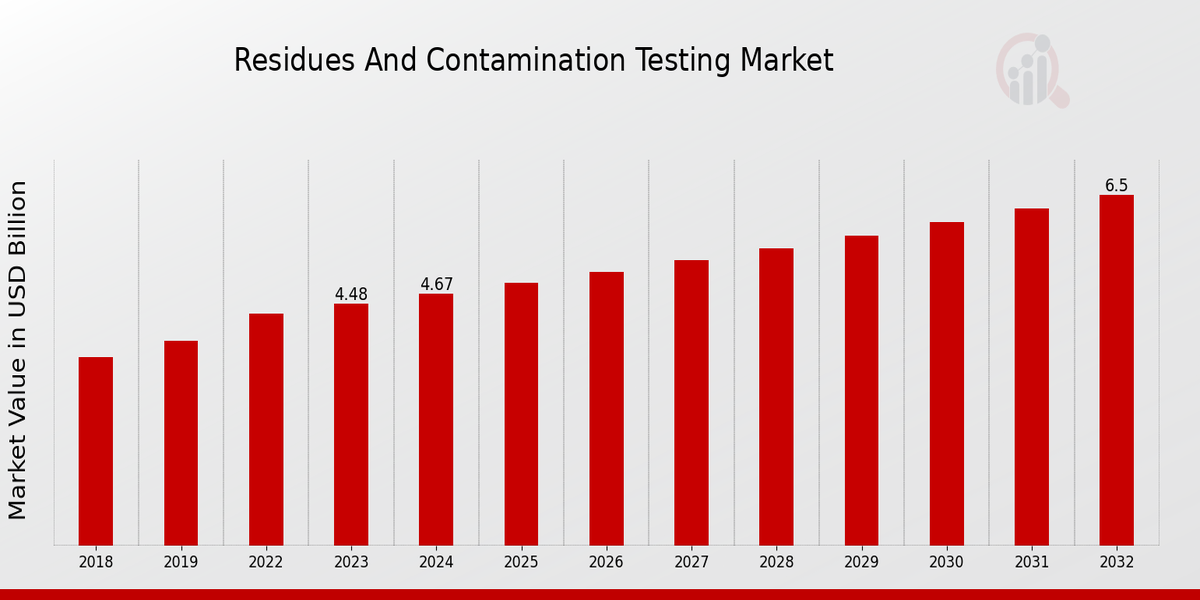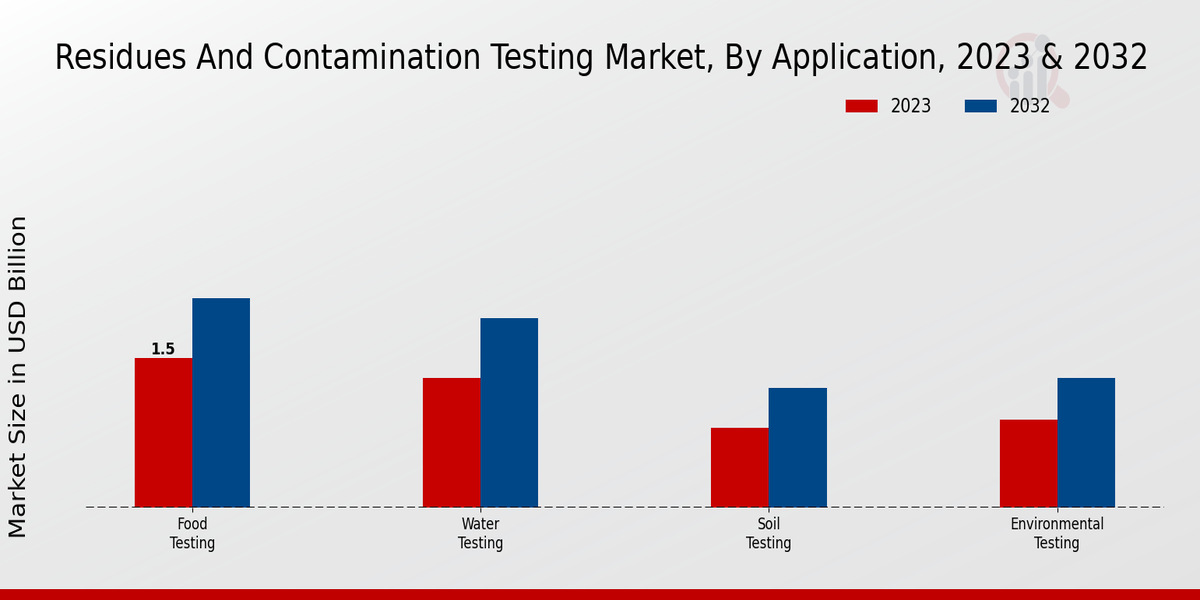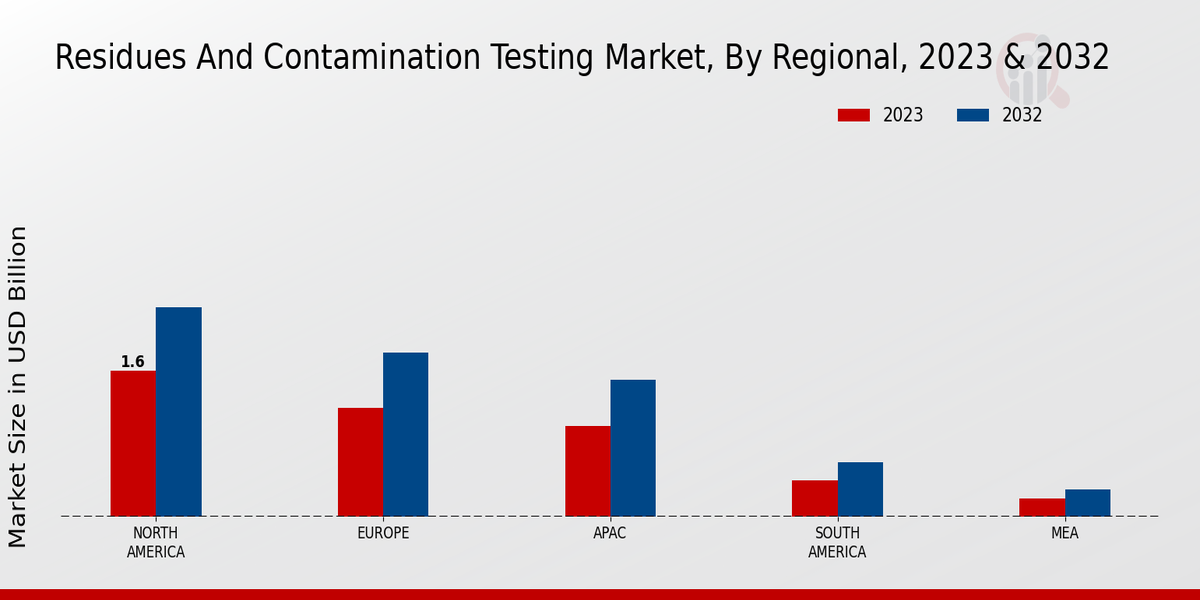Global Residues and Contamination Testing Market Overview
Residues and Contamination Testing Market Size was estimated at 4.3 (USD Billion) in 2022. The Residues and Contamination Testing Industry is expected to grow from 4.48(USD Billion) in 2023 to 6.5 (USD Billion) by 2032. The Residues and Contamination Testing Market CAGR (growth rate) is expected to be around 4.22% during the forecast period (2024 - 2032).

Source Primary Research, Secondary Research, Market Research Future Database and Analyst Review
Key Residues and Contamination Testing Market Trends Highlighted
The Residues and Contamination Testing Market is being shaped by several key market drivers. Increased awareness regarding food safety, coupled with stringent regulatory frameworks, is pushing businesses to invest in residue testing. Rising consumer demand for clean and safe food products propels food manufacturers to ensure their offerings comply with safety standards. Additionally, the growing biotechnology sector is generating a need for robust testing methods to track contamination in diverse production processes, further driving market growth.
This shifting landscape emphasizes the importance of effective contamination testing to protect public health and maintain product integrity.Opportunities within this market are gaining attention as advancements in testing technologies emerge. The rise of rapid testing solutions presents an avenue for businesses to enhance their operational efficiency and reduce time to market. Furthermore, the integration of automation in testing laboratories can streamline procedures, making them more cost-effective. Expanding into emerging markets also offers potential, as regions with maturing regulatory frameworks are becoming more receptive to advanced testing practices.
Companies that can create tailored solutions for different industries, such as agriculture, pharmaceuticals, and food and beverage, are well positioned to capture these opportunities.Recent trends indicate a growing emphasis on sustainability in testing methodologies. As consumers become more environmentally conscious, there is a shift toward eco-friendly testing practices that minimize waste and the use of harmful chemicals. The adoption of technology such as blockchain for tracking supply chain integrity is becoming more prevalent. This technological advancement allows for better transparency and trust in testing results, appealing to both producers and consumers.
Moreover, the rise of digital platforms makes it easier for companies to collaborate and share data, further driving innovation within the residues and contamination testing sector.These trends highlight an evolving market that is adapting to consumer needs and technological advancements.
Residues and Contamination Testing Market Drivers
Increasing Regulatory Standards and Safety Concerns
The Residues and Contamination Testing Market Industry is significantly driven by the rise in regulatory standards and safety concerns regarding food and environmental safety. Governments worldwide are implementing stricter regulations to ensure that food products are free from harmful residues and contaminants. This is fueled by growing public awareness about food safety and health issues arising from contaminated food items.
As a result, food manufacturers and producers are under pressure to comply with these regulations, thereby driving the demand for residues and contamination testing services.These regulatory frameworks not only pertain to food and beverages but also cover pharmaceuticals and environmental sectors, necessitating comprehensive testing to safeguard public health. The need for compliance with these evolving regulations compels organizations to invest in advanced testing solutions, thereby propelling market growth.
Furthermore, with globalization and the increase in trade, there is a heightened focus on standardizing safety testing across borders, which enhances the demand for effective residues and contamination testing.The continuous updates and enhancements in regulatory requirements necessitate that companies adopt more efficient testing methodologies, significantly fueling the Residues and Contamination Testing Market. The industry's continuous advancement, coupled with the necessity for traceability and transparency in testing processes, ensures a steady demand for sophisticated testing solutions, thereby broadening the horizons for further market expansion.
Rising Consumer Demand for Safe and Organic Products
There is a growing consumer preference for safe, organic, and sustainably sourced products, which boosts the Residues and Contamination Testing Market Industry significantly. As consumers become more health-conscious and environmentally aware, they seek assurance that their food and other products are free from harmful residues and contaminants. This shift in consumer behavior is prompting manufacturers to adopt rigorous testing protocols to meet the increasing demand for safe products, thus driving market growth.
Technological Advancements in Testing Methods
Technological advancements are also a crucial driver in the Residues and Contamination Testing Market Industry. Innovations in testing technologies, such as improved detection methods and automated testing processes, enhance the efficiency and accuracy of contamination testing. These advancements not only reduce testing times but also allow for more comprehensive analyses, increasing the reliability of test results. As a consequence, businesses are more inclined to utilize these cutting-edge solutions to ensure product safety, substantially contributing to the market's expansion.
Residues and Contamination Testing Market Segment Insights
Residues and Contamination Testing Market Application Insights
The Residues and Contamination Testing Market is witnessing a steady growth, especially within the Application segment, which includes various critical sectors such as Food Testing, Water Testing, Soil Testing, and Environmental Testing. In 2023, the overall market value is assessed at 4.48 USD Billion, with expectations to reach 6.5 USD Billion by 2032. Among the four applications, Food Testing emerges as a dominant force, valued at 1.5 USD Billion in 2023 and projected to increase to 2.1 USD Billion by 2032.
This significant market share is attributed to rising consumer awareness regarding food safety and regulatory compliance, which drives the need for rigorous testing protocols in the food industry.Water Testing holds another substantial position, valued at 1.3 USD Billion in 2023 and projected to grow to 1.9 USD Billion by 2032. The increasing concerns over water contamination and its impact on health further bolster the importance of this testing application.
Soil Testing, with a valuation of 0.8 USD Billion in 2023 and a forecasted growth to 1.2 USD Billion by 2032, plays a crucial role in agriculture and environmental sustainability, assisting in assessing soil health and suitability for various crops.
Although it holds the least value among these applications, its significance lies in its contribution to maintaining agricultural productivity and environmental health.Lastly, Environmental Testing stands at a valuation of 0.88 USD Billion in 2023, expected to grow to 1.3 USD Billion by 2032, reflecting the increasing focus on environmental conservation and regulatory frameworks that require systematic testing of pollutants and contaminants. Collectively, these segments highlight the varied yet interconnected nature of the Residues and Contamination Testing Market, showcasing the importance of reliable testing in ensuring safety and compliance across multiple sectors.
The market is driven by trends such as rising regulatory initiatives, advancements in testing technologies, and heightened public awareness about contamination risks, presenting ample opportunities for growth.However, challenges like regulatory complexities and the high costs associated with advanced testing systems could impact market expansion. Overall, the market exhibits strong potential, with significant growth anticipated across all application areas, reflecting the critical need for contamination testing in today's increasingly health-conscious and environmentally aware world.

Source Primary Research, Secondary Research, Market Research Future Database and Analyst Review
Residues and Contamination Testing Market Type of Contaminant Insights
The Residues and Contamination Testing Market is projected to be valued at 4.48 USD Billion in 2023 and is expected to expand as various types of contaminants bring increased focus on testing. One significant area within this market is pesticides, which continue to encounter scrutiny due to health risks associated with their use in agriculture, leading to their growing importance in residue testing.
Similarly, heavy metals represent a critical concern given their toxicity and accumulation in the environment, compelling regular testing to safeguard public health.Microorganisms also play a vital role in the market, as their presence in food and water sources can lead to severe health issues, necessitating effective monitoring. Chemical residues are increasingly under the spotlight as regulations tighten around food safety, prompting a demand for comprehensive testing solutions.
As these contaminants present distinct challenges and opportunities within the Residues and Contamination Testing Market, they contribute to the overall market growth by addressing safety and environmental sustainability concerns, thus influencing Residues and Contamination Testing Market data and trends significantly.
Residues and Contamination Testing Market Testing Method Insights
The Residues and Contamination Testing Market focuses significantly on various testing methods, which play a crucial role in ensuring safety and quality across multiple industries. In 2023, the market is valued at 4.48 USD Billion, reflecting the growing importance of reliable contamination testing. Diverse methodologies such as Chromatography, Spectroscopy, Mass Spectrometry, and PCR dominate the market landscape. Chromatography is widely recognized for its effectiveness in separating mixtures, making it essential in quality control processes.Spectroscopy offers versatile analytical capabilities, contributing to its prominence in identifying chemical compositions.
Mass Spectrometry is crucial for its high sensitivity and accuracy, thus making it a preferred choice for detecting minute contaminants. PCR stands out for its rapid testing capabilities, particularly in biological samples, emphasizing its importance in healthcare-related applications. Emerging trends, such as increased regulatory scrutiny and advancements in analytical technologies, are set to drive sustained growth in the Residues and Contamination Testing Market, providing significant opportunities for innovation and expansion within the industry.The market statistics showcase a robust path towards optimizing these testing methods to meet evolving safety standards and consumer demands.
Residues and Contamination Testing Market End Use Insights
The Residues and Contamination Testing Market, valued at 4.48 billion USD in 2023, is experiencing steady growth, with significant contributions from various end-use applications. The agriculture sector plays a crucial role, as it emphasizes the need for safety and quality of crops, directly impacting food supply and public health. Similarly, the food and beverage industry is vital, with an increasing demand for rigorous testing to assure consumers of product safety and compliance with regulatory standards.
Environmental agencies are also key players, focusing on protecting ecosystems through the monitoring of contaminants in soil and water, reflecting the growing concern for environmental health.In the pharmaceuticals sector, the significance lies in ensuring that medical products are free from hazardous residues, which is paramount for patient safety. The Residues and Contamination Testing Market data shows that these segments collectively underscore the importance of testing for maintaining quality, safety, and regulatory compliance across industries, driving market growth.
As the market evolves, trends indicate that technological advancements in testing methods will further enhance the efficiency and reliability of results, presenting opportunities for innovation in the industry.
Residues and Contamination Testing Market Regional Insights
The Residues and Contamination Testing Market is projected to reach a valuation of 4.48 USD Billion in 2023, with significant growth expected across various regions. North America is currently the dominant region, holding a substantial share with a value of 1.6 USD Billion, set to grow to 2.3 USD Billion by 2032, reflecting its robust industrial base and stringent regulatory standards driving market growth.
Europe follows with a valuation of 1.2 USD Billion in 2023 and an expected increase to 1.8 USD Billion, owing to heightened consumer awareness and strong agricultural practices.The APAC region, valued at 1.0 USD Billion in 2023, is anticipated to grow to 1.5 USD Billion as emerging economies increasingly focus on food safety and quality control. South America, with a smaller market at 0.4 USD Billion, is expected to reach 0.6 USD Billion, illustrating gradual improvement in testing facilities and practices.
Lastly, the MEA region stands at 0.2 USD Billion in 2023 and is projected to increase to 0.3 USD Billion, reflecting ongoing advancements in regulatory frameworks and testing technologies. Overall, the regional segmentation highlights varying growth dynamics, with North America and Europe showing significant dominance in the Residues and Contamination Testing Market revenue, while emerging regions like APAC present evolving opportunities due to their developing agricultural sectors and increasing health awareness.

Source Primary Research, Secondary Research, Market Research Future Database and Analyst Review
Residues and Contamination Testing Market Key Players and Competitive Insights
The Residues and Contamination Testing Market is characterized by a rapidly evolving landscape driven by heightened awareness of food safety and environmental sustainability. This market plays a crucial role in ensuring that products meet regulatory standards and consumer expectations regarding safety and quality. With increasing incidences of contamination in food products and rising environmental concerns, the demand for rigorous testing protocols has surged. As a result, a variety of players are vying for market share, utilizing advanced testing technologies and methodologies to enhance their service offerings.
The competitive insights reveal a trend toward innovation and strategic partnerships among market participants, aimed at expanding their capabilities and geographic reach to better serve diverse customer needs.In terms of market presence, SGS has established itself as a formidable force in the Residues and Contamination Testing Market. The company benefits from an extensive network, offering broad geographical coverage and diverse testing services. SGS has a significant advantage due to its strong expertise in the field, possessing state-of-the-art laboratories that enable it to conduct a wide range of residue analysis efficiently.
The company's commitment to quality and compliance is underscored by its continuous investment in research and development, enhancing its testing methodologies. Furthermore, SGS’s reputation for reliability has fostered long-term relationships with clients across various sectors, reinforcing its leadership position within the market. Its scalable solutions and tailored services meet the stringent demands of regulatory compliance and consumer safety, making it a preferred partner for many businesses worldwide.Bureau Veritas also commands a significant presence in the Residues and Contamination Testing Market, leveraging its reputation for quality assurance and risk management.
The company brings a wealth of experience and technical know-how to the table, providing comprehensive testing services that comply with international standards. Bureau Veritas focuses on innovation-driven approaches that streamline and enhance the efficiency of contamination testing processes. Its strong commitment to sustainability aligns with growing market trends, as it emphasizes environmentally responsible practices in its testing methodology. Bureau Veritas’s strategic initiatives often include collaborations and partnerships that further enhance its service portfolio, ensuring that the company remains at the forefront of industry advancements.
The robustness of its testing services and commitment to helping clients manage compliance risks highlight its strengths in the competitive landscape of the market.
Key Companies in the Residues and Contamination Testing Market Include
- Element Materials Technology
Residues and Contamination Testing Market Industry Developments
The Residues and Contamination Testing Market has experienced notable developments recently. SGS has been expanding its testing capabilities to cater to the increasing demand for food safety and quality assurance, reflecting a growing awareness of contamination risks. Bureau Veritas has also been enhancing its service offerings with new technologies to improve testing accuracy and efficiency. In the realm of mergers and acquisitions, LGC Limited has undertaken strategic acquisitions to strengthen its position within the market, capitalizing on the rising need for reliable testing solutions.
Eurofins Scientific announced plans to broaden its laboratory network to improve service delivery and meet rising client demands. Additionally, Neogen Corporation has reported significant growth, attributed to its innovative testing products which are gaining traction in various segments, hence positively impacting overall market valuation. Alongside, Element Materials Technology has been reinforcing its laboratories' capabilities to provide better contamination testing, aligning with the industry's increasing regulatory pressures. Such activities underline the market’s dynamic nature and its responsiveness to evolving consumer needs and regulatory standards.
Residues and Contamination Testing Market Segmentation Insights
-
Residues and Contamination Testing Market Application Outlook
-
Residues and Contamination Testing Market Type of Contaminant Outlook
-
Residues and Contamination Testing Market Testing Method Outlook
-
Residues and Contamination Testing Market End Use Outlook
- Food and Beverage Industry
-
Residues and Contamination Testing Market Regional Outlook
| Report Attribute/Metric |
Details |
| Market Size 2022 |
4.3(USD Billion) |
| Market Size 2023 |
4.48(USD Billion) |
| Market Size 2032 |
6.5(USD Billion) |
| Compound Annual Growth Rate (CAGR) |
4.22% (2024 - 2032) |
| Report Coverage |
Revenue Forecast, Competitive Landscape, Growth Factors, and Trends |
| Base Year |
2023 |
| Market Forecast Period |
2024 - 2032 |
| Historical Data |
2019 - 2023 |
| Market Forecast Units |
USD Billion |
| Key Companies Profiled |
SGS, Bureau Veritas, Romer Labs, LGC Limited, Element Materials Technology, Merck KGaA, Fera Science Limited, Intertek, Neogen Corporation, Agilent Technologies, Thermo Fisher Scientific, Silliker, Elisa Technologies, Mérieux NutriSciences, Eurofins Scientific |
| Segments Covered |
Application, Type of Contaminant, Testing Method, End Use, Regional |
| Key Market Opportunities |
Emerging regulations for food safety, Expansion in agricultural testing, Rising demand for environmental testing, Advanced technologies for rapid analysis, Growing awareness of health standards |
| Key Market Dynamics |
Rising food safety regulations, Increasing consumer awareness, Advancements in testing technology, Growth in agricultural practices, Expansion of pharmaceutical industry |
| Countries Covered |
North America, Europe, APAC, South America, MEA |
Frequently Asked Questions (FAQ):
The Residues and Contamination Testing Market is expected to be valued at 6.5 USD Billion in 2032.
The projected CAGR for the Residues and Contamination Testing Market is 4.22% from 2024 to 2032.
North America is expected to have the largest market share, valued at 2.3 USD Billion in 2032.
The market value of Food Testing is expected to reach 2.1 USD Billion in 2032.
Key players include SGS, Bureau Veritas, Romer Labs, and Element Materials Technology among others.
Environmental Testing is expected to reach a market size of 1.3 USD Billion in 2032.
The Water Testing segment is valued at 1.3 USD Billion in 2023.
Soil Testing is projected to have a market size of 1.2 USD Billion in 2032.
Europe's market value is expected to reach 1.8 USD Billion in 2032.
The MEA region is expected to reach a market value of 0.3 USD Billion in 2032.

















